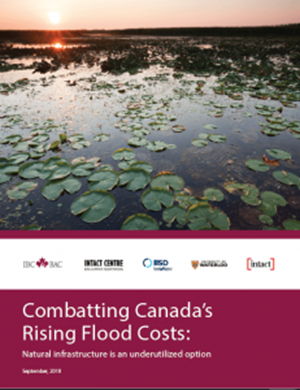Moudrak, N., Feltmate, B., Venema, H., Osman, H. (2018). Combating Canada’s Rising Flood Costs: Natural infrastructure is an underutilized option. Prepared for Insurance Bureau of Canada. Intact Centre on Climate Adaptation,
University of Waterloo Beyond the specific methods needed to assess and compare grey infrastructure against natural infrastructure options relative to their utility to mitigate risk, a framework is required that would provide guidance to those considering or opting for a natural infrastructure solution.
This report presents ample evidence to suggest that efforts by governments to limit flood risk may be consistent with – and reinforce – their fiduciary responsibility to administer good governance.
Flood risk is mounting across Canada from fluvial sources, such as rivers and lakes; pluvial sources, such as intense rainfall inundating urban environments; and coastal sources, such as storm surges compounded by rising sea levels.
The financial impacts of climate change and extreme weather events are being felt by a growing number of homeowners and communities across Canada. The increase in P&C insurance losses is indicative of the growing costs associated with these events. These losses averaged $405 million per year between 1983 and 2008, and $1.8 billion between 2009 and 2017. Water damage is the key driver behind these growing costs. Fortunately, as documented in this report, flood risk can be limited through conservation and restoration of natural infrastructure features, such as ponds, wetlands, and vegetated areas. This report demonstrates how to quantify the benefits and costs of these natural features as a strong complement or a viable alternative to grey infrastructure option for flood mitigation. As a general “rule of thumb”, in order of preference, the most cost-effective means to mitigate flood losses utilizing natural systems is to:
(i) retain what you have;
(ii) restore what you’ve lost; and
(iii) build what you must.
The Return on Investment of Natural Infrastructure (Infographic)






